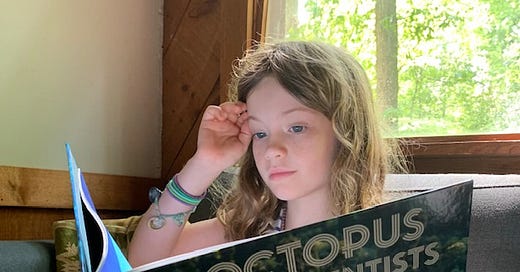This week, our last animal-of-the-week for a while, we decided to focus on a creature we don’t get to see—except in books, movies, or maybe at an aquarium—the octopus!
These amazing animals—there are around three hundred different species—are not only beautiful and interesting, they’re also very smart and curious. Just check out this video of Elora and her friend Egbert, a pygmy octopus:
You may have seen the Oscar-winning documentary My Octopus Teacher, which follows a filmmaker for a whole year as he befriends an octopus (Eight tentacles up, Bea says about this movie). It may seem strange for a person to become “friends” with a mollusk, but many scientists and science writers have reported feeling a strong pull of affection, and even understanding, between themselves and octopuses (yes, it’s octopuses, not octopi!). Maybe this is in part because octopuses can recognize human faces, and when they decide that they like you, it feels pretty special.
We’re enjoying the book Bea is reading in the photo above, The Octopus Scientists by Sy Montgomery. It’s part of a series called Scientists in the Field that our friend Julia recommended—her mentor is profiled in The Hyena Scientist. We appreciate these books (we also got The Hyena Scientist) because they have beautiful photos and don’t talk down to kids. They’d be great books for a classroom.
Some other cool facts about octopuses:
They have three hearts—one to pump to the body, and two to pump to the gills.
Even stranger, they have nine brains! One donut-shaped brain for their head, and one for each tentacle!
They have blue blood! This is because the protein that is in their blood has copper, rather than iron. This blood component helps them navigate many different temperatures, from 28 degrees Fahrenheit to superheated temperatures near ocean vents.
Octopuses have eight tentacles. They use these tentacles for many things, including walking along the ocean floor, hunting, self-defense, and to know what they are touching. The suckers on the underside of the octopus’s tentacles can both taste and touch.
Some octopuses live in “cities” (Octopolis and Octlantis are two octopus cities).
Octopuses can use tools and make plans. (In the video with Elora and Egbert, it looks like Egbert is using Elora’s fingers as a tool to move an underwater log.)
They also have amazing camouflage skills. They are colorblind but can color-match, pattern-match, and can even change their skin texture to hide from predators (or to hunt prey). This Science Friday video is pretty mind-blowing:
Octopuses can also solve mazes and problems, and even extremely large octopuses can squeeze through tiny holes (even ones the size of a quarter!) to escape. Here is a video showing one such escape:
This article in Scientific American explains a little about octopus smarts, including the idea that their intelligence evolved to meet the demands of the complex ecosystem many live in: the coral reef.
The writer also tells this story about an octopus escape:
There's a famous story from the Brighton Aquarium in England 100 years ago that an octopus there got out of its tank at night when no one was watching, went to the tank next door and ate one of the lumpfish and went back to his own tank and was sitting there the next morning. The aquarium lost several lumpfish before they figured out who was responsible.
Do you know any cool octopus facts? Please share in the comments, and look for more about the octopus in mythology and storytelling, as well as the threats to the octopus, on Friday!





Best issue yet!!